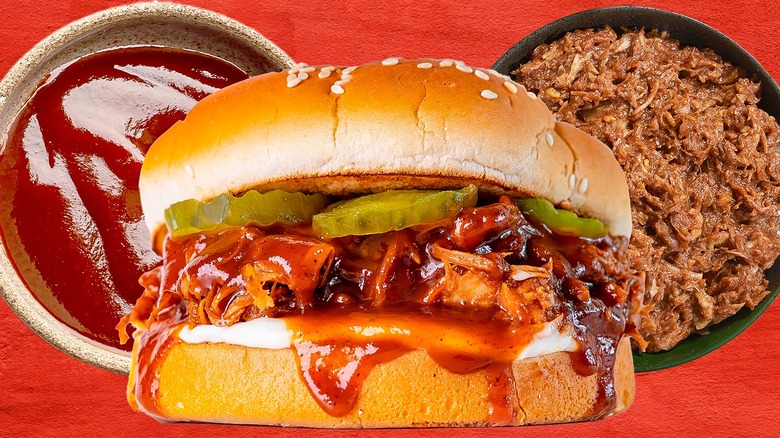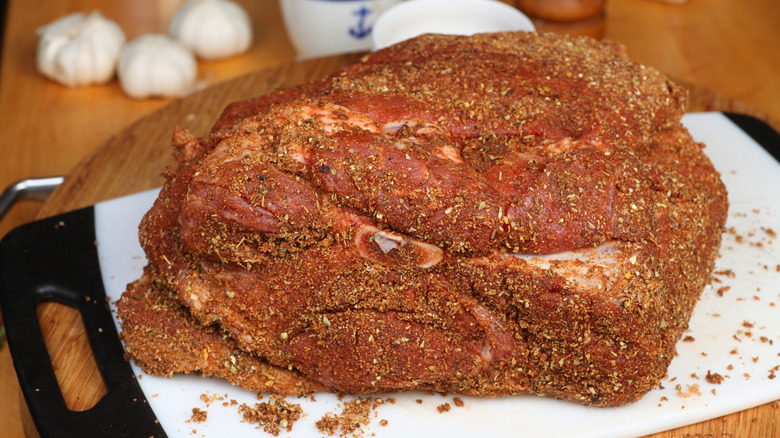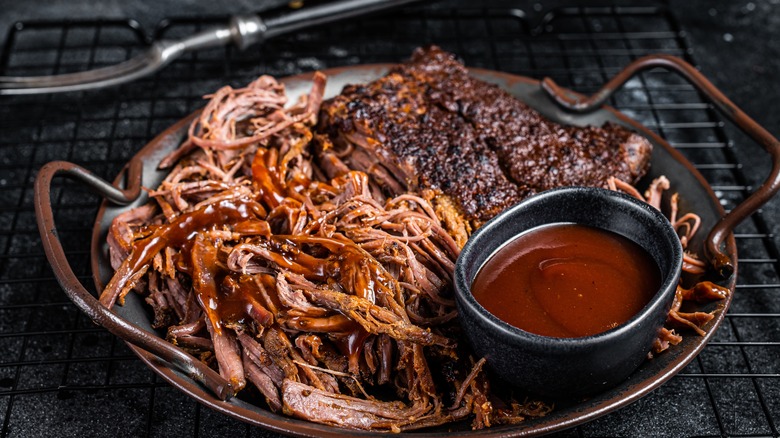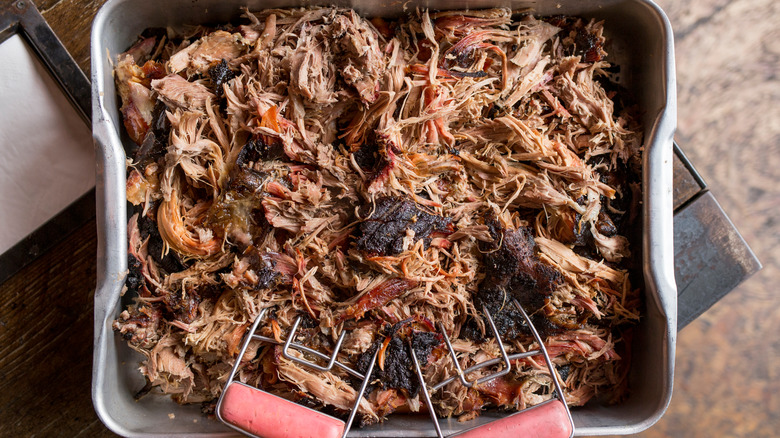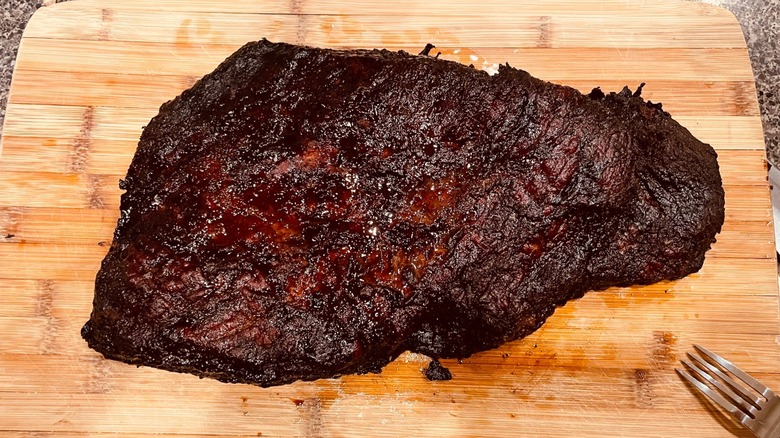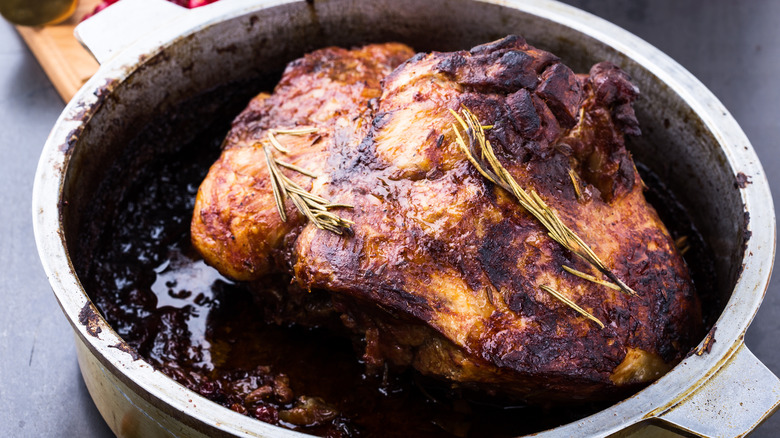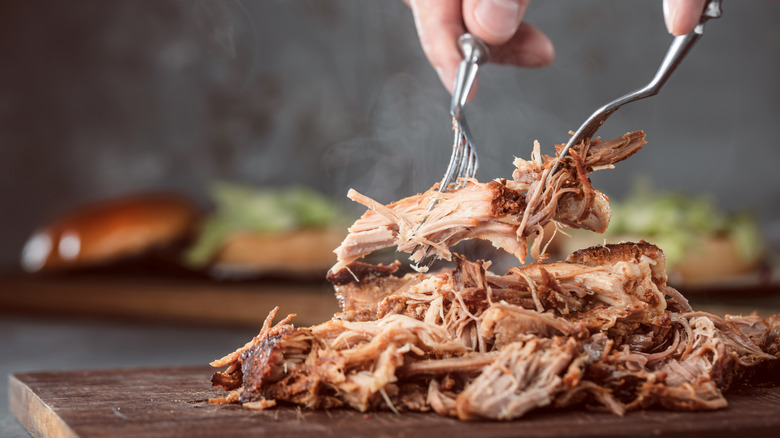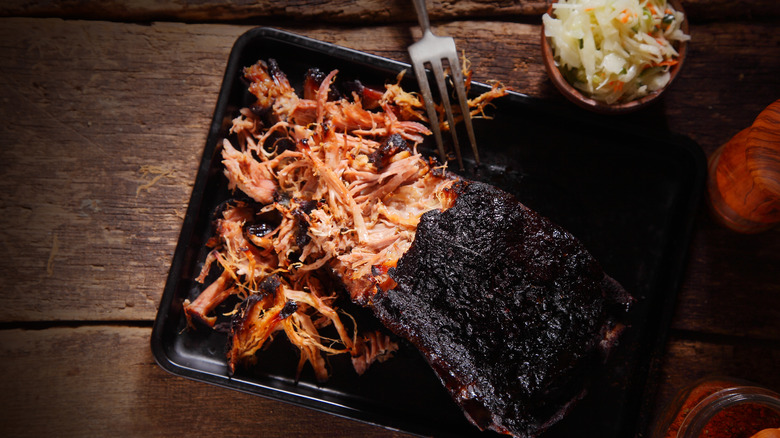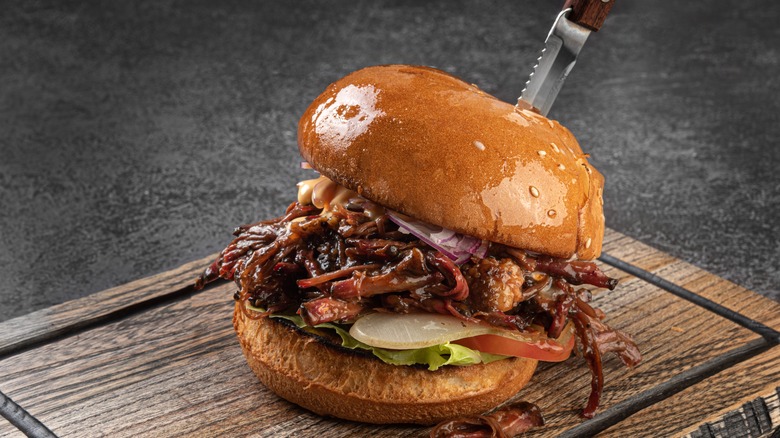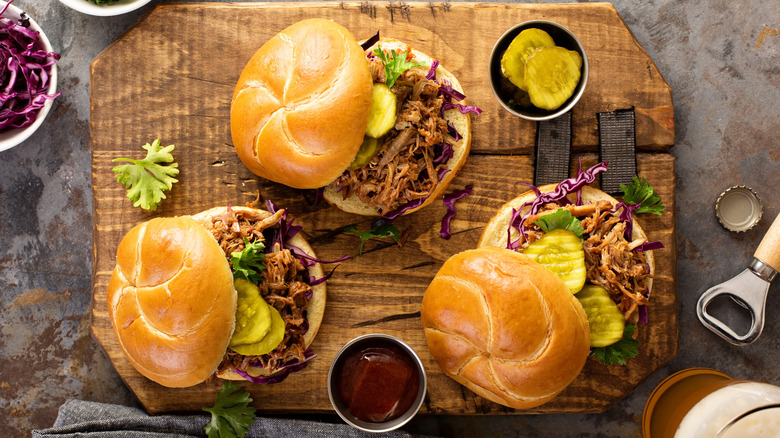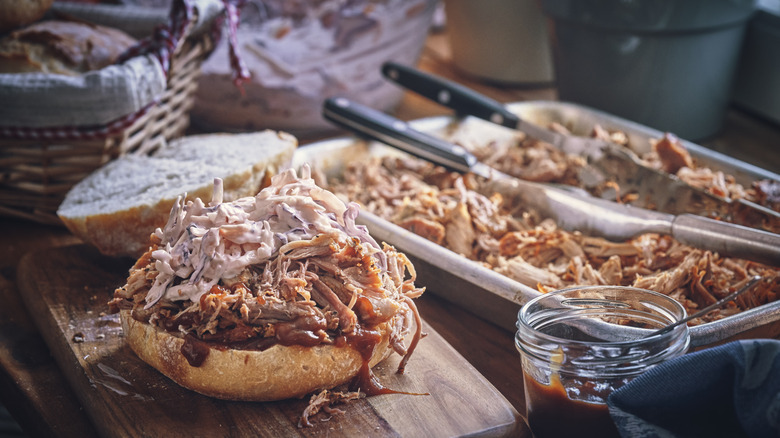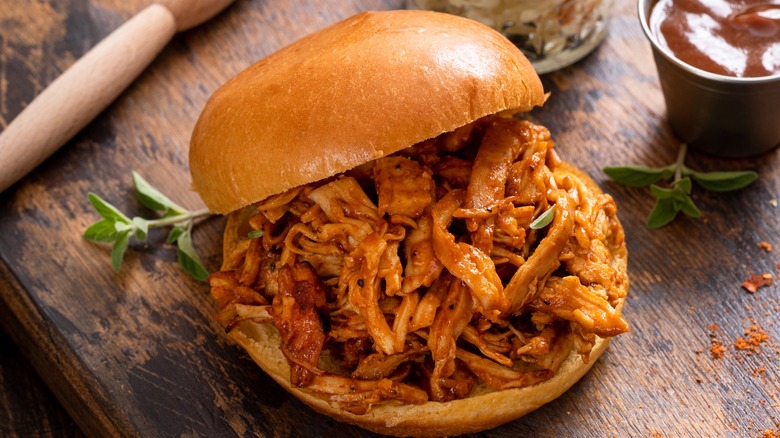12 Mistakes Everyone Makes With Pulled Pork Sandwiches, According To A Professional Cook
There's little as satisfying as the tender, fatty, savory meat of pulled pork, and when you add all the fixings into a fluffy bun, you have the most incredible sandwich. Salty, sweet, smoky, and more, it makes for a delicious lunch, dinner, or snack for adults and kids alike. Plus, it's great for feeding a lot of people. While it's the type of food you can eat all year round, it's also the perfect food to take to a picnic, potluck, beach day, or barbecue, and as the weather gets warmer, these are all on the horizon.
The secret to a successful pulled pork that's soft and succulent is that it's cooked low and slow. It's the type of meat you simply cannot rush or the meat will be tough and hard to chew. It's a relatively easy piece of meat to cook if you know what you're doing, and it can be cooked both in your oven or a smoker. In fact, it's a good place to start if you're learning how to use a smoker, because it's a relatively forgiving cut. However, there are a few ways it can go wrong and leave you disappointed. As a professional cook and recipe developer, I've made pulled pork sandwiches countless times, making common mistakes and learning some tricks along the way. These are some of the mistakes that everyone makes with pulled pork sandwiches and how to avoid them.
1. Using the wrong cut of pork
Pulled pork is all about using the right cut of meat to achieve that soft, juicy meat that falls off the bone. Not all cuts of the pig will work, and some will come out tougher than others. You can't use a lean cut of meat to make pulled pork, or you'll end up with tough or dried out meat. The best cut of pork to use is pork shoulder, or better yet, the cut commonly referred to as "pork butt." Don't be confused — it's got nothing to do with the pig's behind. It refers to the thicker part of the shoulder, often including the bone and shoulder blade, parts of the neck, and upper arm.
The fat and connective tissue of the "pork butt" melt into the meat, keeping it moist as it cooks, making it a great cut to avoid your meat drying out. Its intense marbling means it naturally bastes itself and you won't have to take it out and baste it like other cuts of meat. Plus, if you opt for a bone-in cut, like a pork butt, there will be added juiciness and savory flavor from the marrow and collagen as it breaks down. If you need any more convincing, bone-in cuts will also be more affordable than asking for a boneless cut.
2. Not giving the pork enough time to marinate
Pulled pork may take a while to make, but the end result is so worth it. Although you may know it takes hours to cook, you also need to factor in at least one night extra for the pork to marinade. While pulled pork already tastes great, thanks to the juicy fat and meat, it's a great meat to add flavorings and seasonings to. Especially since you can go a whole number of ways, sweet and smoky, spicy and savory, and more. This is where a dry rub marinade comes in. Of course, people may use pre-made barbecue sauces or do oil marinades, but a dry rub is really all you need, as your meat has enough moisture and fat without any extra help.
As it's such a large cut of meat, and the spices are going to be coating the outside, you need to let it marinade for long enough so that the spices can penetrate and seep into the meat. Where many people go wrong is that they add their rub right before cooking. This will only flavor the outer layer of meat. To ensure your spices marinade through, let your seasoned pork sit in the fridge overnight, or longer. Furthermore, the best method for adding the dry rub is to ensure your meat is patted dry beforehand. Any moisture on the surface won't allow the rub to adhere to the meat properly.
3. Undercutting the cooking time
When you're cooking a piece of pork shoulder that's full of connective tissue, muscle, and fat, there's nothing other than time that can break all those down. That's what's going to melt, render, and soften into that gelatinous, fatty, meaty pork that we know and love. Not allowing it to cook over the required time is one of the most common mistakes people make. I get it, the impatience is natural when it's smelling so good and your hunger is growing. Or perhaps you've underestimated how many hours it's going to take and started cooking too late. To avoid stress and disappointment, it's always best to plan ahead to avoid this and cook the pork way in advance of whatever event or meal you plan on serving it at.
The cooking time is going to vary depending on the size of your shoulder. A larger piece of meat will take longer than one that's on the smaller size. You can expect your cooking time to be at least about four hours, but it can go up to six or eight if it's on the larger side. Don't be concerned with overcooking it, because this cut of meat is very forgiving and takes a lot to overcook it.
4. Cooking the pork straight out of the fridge
Time and temperature are such important factors to consider when it comes to making pulled pork. You don't need to do much actual active cooking on a stove, or even chopping and preparing foods, but you do need to have the patience to let the meat marinade and cook in the time it needs. Perhaps one of the biggest prep mistakes people make with pulled pork is to remember to let the meat get to room temperature before cooking. Yes, another step with waiting at least a few hours is required. Too often, (with all types of meat) people take the meat out from the fridge as they're about to cook it.
This will not only extend the cooking time in total, but also could result in an unevenly cooked piece of pork. Foregoing this step could also lead to burnt edges because the center of the meat is cold and requires longer cooking than the outside. Whether you're braising in the oven, or cooking it in a smoker, you need an extra step to ensure perfect cooking.
5. Rushing the resting
Even though you've done all the necessary waiting in order to let the meat marinade, get to room temperature before cooking, and then cook it for as long as it needs, there's one last step that requires restraint. For this one, it's hard to blame anyone for making this mistake. The aromas of the meat have filled the air for the hours you've taken to gently and lovingly cook your pork. The meat has finally become tender, juicy, and is falling apart just enough that you can start to pull it. Sadly, you can't immediately dig in and shred it just yet. You need to give it enough time to rest first. If you start shredding it too soon, it can dry out the meat. Resting it allows the flavors to settle and lock into the meat as it reconstitutes.
Just how long you should rest your pork all depends on the size of the cut and the method of cooking. However, a good rule of thumb is to let it rest for about 45 minutes. In fact, it's better to do the shredding right before you're about to serve it. Of course, if you're dying to taste your creation, there's no harm in cutting a little piece for yourself to try.
6. Adding too much liquid while cooking
People often add a braising liquid to their piece of pork while cooking. This ensures your meat is moist and doesn't dry out in the hours that it's in your oven, smoker, or whatever you're using to cook it. However, where people sometimes go wrong is by drowning the meat in the liquid and adding too much. You want to make sure you have just enough liquid that it can steam through the meat and keep it juicy. Too much, and your meat can get mushy, or you can drown out the flavors of your dry rub or marinade.
The ideal amount of liquid to use can change depending on the liquid and size of your piece of pork. However, a 2-to-1 ratio is a good place to start, where you have double the amount of meat to your liquid. You can also go with about half a cup of liquid per pound of meat. When it comes to what liquids to use, there are plenty of options. A common choice is to use cider, or beer, but you can also use sodas like Dr. Pepper, or Coke. Or, you could make a liquid using juice or vinegar, and other sauces and seasonings, like Worcestershire sauce, soy sauce, sriracha, or ketchup. The possibilities are endless.
7. Shredding (pulling) it too much
Probably the most fun part of making pulled pork is when it's time to "pull" it apart. Shredding it should be incredibly easy if you've cooked it long enough that the meat is tender. It will fall apart without effort as you use a fork (or your hands) to agitate it and shred it. However, while you're enjoying the feeling of breaking it all apart, you might take it too far. It's best to shred with some restraint and leave some pieces bigger than others.
Larger chunks add more of a dynamic texture and will improve the eating experience. They're satisfying to bite on especially as the meat will be soft and melt in your mouth. Plus, the meat is going to keep shredding as you mix it up with the sauce or seasonings, as you pick it up and move it around. Leaving some decent sized chunks will allow you some room for that, while still keeping some bits intact. It will also hold together better when you serve it in your buns so that the meat isn't falling out whenever you take a bite.
8. Leaving out the acid
What makes pulled pork so delicious is all that fat that has melted into the meat and basted it while cooking. However, when made without anything to cut through the richness, the fattiness can be overwhelming, or greasy. This is why it's always a good idea to incorporate acid into your cooking liquid. This creates a perfect balance of flavor and the liquid ensures the meat stays moist. You can use lemon juice, vinegar, wine, or in keeping with flavors that go great with pork like apple, a splash of apple cider, or apple cider vinegar.
If you're smoking your pork rather than braising it in the oven, there's a technique called "spritzing" which can help keep your pork moist as you cook. Simply add some vinegar in a spray bottle, and give your pork a "spritz" every 30 minutes or so (after an initial two hours with no liquid so that the pork isn't too wet at first). This helps to replenish any lost moisture during the smoking.
9. Selecting the wrong bread
You've gone through all the effort of perfecting the cooking of your pulled pork. It's taken hours and careful consideration to get to the point where you're ready to start assembling your pulled pork bun. This is why you need to use the right bread. You don't want to miss the mark, right at the finish line. The bread you use for your pulled pork bun is what will be the carrier for your tender, delicate, meat, and it should be soft, yet sturdy enough to hold it without falling apart. Plus, you want to make sure it's fresh, and in no way a little stale or dry, or the whole sandwich will be subpar.
You can and should always use the type of bread that you love to eat, but if you're wondering what the ideal bread is, soft buns are key to tasty pulled pork sandwiches. They're fluffy and pillowy, while firm enough to keep together the weight and sauciness of the meat and other toppings. Some other options are Hawaiian rolls or hamburger buns. They'll be able to absorb all the sauce and flavor without falling apart. Still, if you want a sturdier bread, you can try a ciabatta or sourdough buns.
10. Forgetting to add something pickled
If you've taken care to add a lot of flavor to your pork and cooked it perfectly, you're probably wondering why your pulled pork bun isn't hitting the spot like you expected. Sometimes, the answer is extremely simple. It might just be missing some pickles. Just as pulled pork needs some acid while cooking, your pulled pork bun will benefit from adding something pickled to it. Adding some sliced pickles, cornichons, pickled onions, or even sauerkraut will add a hit of salty sourness, providing some much needed relief from the fatty richness of the pulled pork.
This creates a perfect, all well rounded bite. And, if you've gone the sweet route and make a sweet pulled pork marinade, the pickles will balance the sweetness too. Pickles also add texture to an otherwise one note (in terms of texture) sandwich where everything is quite soft. It will be more pleasant to have some crunch to go along with the tender meat and pillowy bun.
11. Preparing in advance will get you soggy sandwiches
While pulled pork is the perfect, make ahead food, you don't want to make your sandwiches too much in advance. Like with any type of sandwich, the bread can become soggy if it sits too long with its fillings, especially if those fillings are moist. If you've made a juicy dish of pulled pork, it's likely that it has some drippings or sauce which will absorb into the bread. This not only makes your bread mushy, but can also dry out the fillings as the bread soaks it all up.
The best plan of action with pulled pork is to fill your buns and assemble the sandwiches, right before serving. This might mean you don't have food that's immediately ready to eat, but it doesn't take too long to assemble everything once it's all prepared. Therefore, if you're heading out to a picnic, pack your buns and meat separately. You can also pre-slice your pickles, or prepare your slaw or salad toppings in advance, as long as you keep everything separate. To make the process less labor and time consuming, you can invite everyone to assemble their own buns. This makes it more interactive and everyone can serve themselves their preferred ratios.
12. Over-saucing can ruin your pulled pork sandwich
Everyone has their preference for what makes the best pulled pork sandwich. From how much meat to serve on your bun, to how spicy it should be, or whether you should add a tangy slaw or do without it. The matter of sauce or no sauce is also part of the discussion, but whether you're a pulled pork puritan, or you like your meat to be smothered in barbecue sauce, there are no rules. However, there is a rule about just how much sauce you should be adding. This is because too much sauce can destroy your pulled pork sandwich.
One of the best parts is having the meat juice or sauce running down your chin as you indulge in each bite. But, less is more when it comes to sauce. Too much and it will not only make your sandwich soggy faster, but it will also overpower the flavor of the pork. You've likely gone to the effort of seasoning your pork with a bunch of delicious spices, and you want those flavors, and the flavor of the meat to come through. The trick is to add just enough sauce to make your sandwich juicy and give it a hint of the taste, without drowning your meat in it. You can always keep some sauce on the side to add more later if it needs it.
